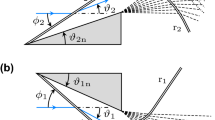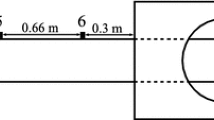Abstract
The Kelvin–Helmholtz instability (KHI) is an instability that takes the form of repeating wave-like structures which forms on a shear layer where two adjacent fluids are moving at a relative velocity to one another. Such a shear layer forms in the Mach reflection of shock waves. This work focuses on experimentally visualising the presence of the KHI in Mach reflection as well as its evolution. Experimentation was performed at shock Mach numbers of 1.34, 1.46 and 1.61. Plane test pieces and parabolic profiled pieces followed by a plane section having wedge angles of 30\(^\circ \) and 38\(^\circ \) were tested. Flow field visualisation was performed with a schlieren optical system. The KHI was best visualised with the camera-side knife edge perpendicular to the shear layer (i.e. the axis of sensitivity along the length of the shear layer). The structure and growth of the instability were readily identified. The KHI forms more readily with increasing Mach number and wedge angle. Second-order Euler, and Navier–Stokes numerical simulations of the flow field were also conducted. It was found that the Euler and laminar Navier–Stokes solvers achieved very similar results, both producing the KHI, but at a much less developed state than the experimental cases. The k\(-\epsilon \) solver, however, did not produce the instability.
























Similar content being viewed by others
References
Smits, A.J., Dussauge, J.P.: Turbulent shear layers in supersonic flow. Springer, Berlin (2006)
Papamoschou, D., Roshko, A.: The compressible turbulent shear layer: an experimental study. J. Fluid Mech. 197, 453–477 (1988)
Drazin, P.G.: Introduction to Hydrodynamic Stability. Cambridge Texts in Applied Mathematics. Cambridge University Press, Cambridge (2002)
Rikanati, A., Sadot, O., Ben-Dor, G., Shvarts, D., Kuribayashi, T., Takayama, K.: Shock-wave Mach-reflection slip-stream instability: a secondary small-scale turbulent mixing phenomenon. Phys. Rev. Lett. 96, 174503 (2006)
Brown, G.L., Roshko, A.: On density effects and large structure in turbulent mixing layers. J. Fluid Mech. 64, 775–816 (1974)
Skews, B., Kleine, H., Bode, C., Gruber, S.: Shock wave reflection from curved surfaces. In: Denier, J., Finn, M.D., Mattner, T. (eds.) XXII ICTAM Proceedings, Adelaide, (August 2008)
Gvozdeva, L.G.: Study of mixing layers arising in the diffraction of shock waves. In: Znamenskaya I.A. (ed.) PSFVIP-8 Proceedings, Moscow, (August 2011)
von Neumann, J.: Collected Works of J. von Neumann, Vol. 6. Pergamon Press, Oxford (1963)
Dowse, J.N., Ivanov, I.E., Kryukov, I.A., Skews, B.W., Znamenskaya, I.A.: Kelvin–Helmholtz instability on shock propagation in curved channel. In: 15th International Symposium on Flow Visualization, Minsk, (June 2012). ISBN: 978-985-6456-75-9
Acknowledgments
This research was supported by a Grant from the South African National Research Foundation.
Author information
Authors and Affiliations
Corresponding author
Additional information
Communicated by H. Olivier.
Rights and permissions
About this article
Cite this article
Rubidge, S., Skews, B. Shear-layer instability in the Mach reflection of shock waves. Shock Waves 24, 479–488 (2014). https://doi.org/10.1007/s00193-014-0515-6
Received:
Revised:
Accepted:
Published:
Issue Date:
DOI: https://doi.org/10.1007/s00193-014-0515-6




